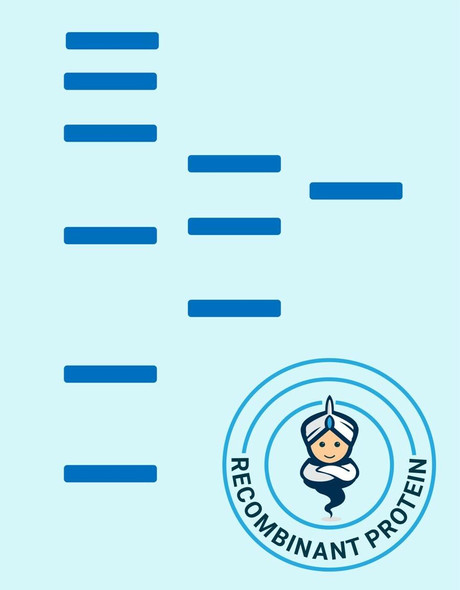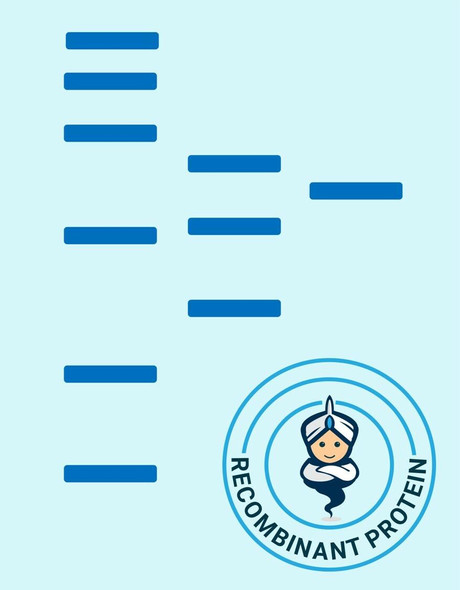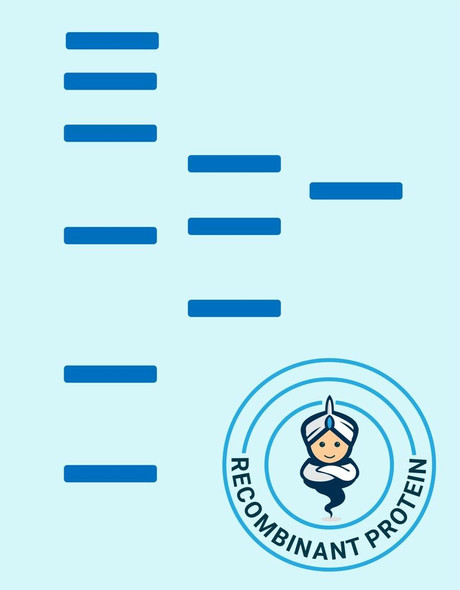Chemokines Recombinant Proteins
Human MCP 4 Recombinant Protein (RPPB1197)
- SKU:
- RPPB1197
- Product Type:
- Recombinant Protein
- Species:
- Human
- Uniprot:
- Q99616
- Research Area:
- Chemokines
Description
| Product Name: | Human MCP 4 Recombinant Protein |
| Product Code: | RPPB1197 |
| Size: | 10µg |
| Species: | Human |
| Target: | MCP 4 |
| Synonyms: | Small inducible cytokine A13, CCL13, Monocyte chemotactic protein 4, MCP-4, Monocyte chemoattractant protein 4, CK-beta-10, NCC-1, chemokine (C-C motif) ligand 13, NCC1, CKb10, SCYL1, SCYA13, MGC17134. |
| Source: | Escherichia Coli |
| Physical Appearance: | Sterile Filtered White lyophilized (freeze-dried) powder. |
| Formulation: | The protein was lyophilized from a concentrated (1mg/ml) sterile solution in 20mM PB, pH 7.4, 130mM NaCl. |
| Solubility: | It is recommended to reconstitute the lyophilized MCP-4 in sterile 18M-cm H2O not less than 100�g/ml, which can then be further diluted to other aqueous solutions. |
| Stability: | Lyophilized MCP-4 although stable at room temperature for 3 weeks, should be stored desiccated below -18°C. Upon reconstitution�MCP-4 should be stored at 4°C between 2-7 days and for future use below -18°C. For long term storage it is recommended to add a carrier protein (0.1% HSA or BSA).Please prevent freeze-thaw cycles. |
| Purity: | Greater than 96.0% as determined by:(a) Analysis by RP-HPLC.(b) Analysis by SDS-PAGE. |
| Amino Acid Sequence: | QPDALNVPSTCCFTFSSKKISLQRLKSYVITTSRCPQKAVIFRTKLGKEICADPKEKWVQNYMKHLGRKAHTLKT |
| Biological Activity: | The specific activity as determined by the ability of MCP-4 to chemoattaract human monocytes at 10-100ng/ml, corresponding to a Specific Activity of 10,000-100,000 units/mg. |
Chemokine (C-C motif) ligand 13 (CCL13 / MCP-4) is a small cytokine belonging to the CC chemokine family.�The MCP-4 gene is located on human chromosome 17 within a large cluster of other CC chemokines. MCP-4 induces chemotaxis in monocytes, eosinophils, T lymphocytes, and basophils by binding cell surface G-protein linked chemokine receptors such as CCR2, CCR3 and CCR5. Activity of the MCP-4�chemokine has been implicated in allergic reactions such as asthma. MCP-4 can be induced by the inflammatory cytokines interleukin-1 and TNF-a.
Monocyte Chemotactic Protein-4 Human Recombinant produced in E.Coli is a non-glycosylated, Polypeptide chain containing 75 amino acids and having a molecular mass of 8.6 kDa. The MCP-4 is purified by proprietary chromatographic techniques.
| UniProt Protein Function: | CCL13: Chemotactic factor that attracts monocytes, lymphocytes, basophils and eosinophils, but not neutrophils. Signals through CCR2B and CCR3 receptors. Plays a role in the accumulation of leukocytes at both sides of allergic and non-allergic inflammation. May be involved in the recruitment of monocytes into the arterial wall during the disease process of atherosclerosis. May play a role in the monocyte attraction in tissues chronically exposed to exogenous pathogens. By IL1/interleukin-1 and TNF. Widely expressed. Found in small intestine, thymus, colon, lung, trachea, stomach and lymph node. Low levels seen in the pulmonary artery smooth muscle cells. Belongs to the intercrine beta (chemokine CC) family. |
| UniProt Protein Details: | Protein type:Secreted, signal peptide; Motility/polarity/chemotaxis; Chemokine; Secreted Chromosomal Location of Human Ortholog: 17q11.2 Cellular Component: extracellular space Molecular Function:chemokine activity; receptor binding Biological Process: cellular calcium ion homeostasis; regulation of cell shape; cell-cell signaling; eosinophil chemotaxis; cytoskeleton organization and biogenesis; immune response; signal transduction; inflammatory response; chemotaxis |
| NCBI Summary: | This antimicrobial gene is one of several Cys-Cys (CC) cytokine genes clustered on the q-arm of chromosome 17. Cytokines are a family of secreted proteins involved in immunoregulatory and inflammatory processes. The CC cytokines are proteins characterized by two adjacent cysteines. The cytokine encoded by this gene displays chemotactic activity for monocytes, lymphocytes, basophils and eosinophils, but not neutrophils. This chemokine plays a role in accumulation of leukocytes during inflammation. It may also be involved in the recruitment of monocytes into the arterial wall during artherosclerosis. [provided by RefSeq, Sep 2014] |
| UniProt Code: | Q99616 |
| NCBI GenInfo Identifier: | 3024128 |
| NCBI Gene ID: | 6357 |
| NCBI Accession: | Q99616.1 |
| UniProt Related Accession: | Q99616 |
| Molecular Weight: | |
| NCBI Full Name: | C-C motif chemokine 13 |
| NCBI Synonym Full Names: | C-C motif chemokine ligand 13 |
| NCBI Official Symbol: | CCL13�� |
| NCBI Official Synonym Symbols: | NCC1; CKb10; MCP-4; NCC-1; SCYL1; SCYA13�� |
| NCBI Protein Information: | C-C motif chemokine 13 |
| UniProt Protein Name: | C-C motif chemokine 13 |
| UniProt Synonym Protein Names: | CK-beta-10; Monocyte chemoattractant protein 4; Monocyte chemotactic protein 4; MCP-4; NCC-1; Small-inducible cytokine A13Cleaved into the following 3 chains:C-C motif chemokine 13, long chain; C-C motif chemokine 13, medium chain; C-C motif chemokine 13, short chain |
| Protein Family: | Meiotic coiled-coil protein |
| UniProt Gene Name: | CCL13�� |
| UniProt Entry Name: | CCL13_HUMAN |






